Stabilization and Housing
Stabilization and Housing
Conservation of library and archive collections is significantly advanced with the help of stable, protective enclosures. For unbound materials in particular, enclosures protect them from damage and create a micro-environment. It is important, however, to ensure that the enclosures be purchased from a reputable vendor and that they are manufactured from chemically stable materials with a high pH. Objects stored in enclosures made from highly acidic materials will deteriorate faster than normal.
Enclosures form micro-environments for controlling humidity and insect infestation and for protecting against environmental damage such as particulates and fires through the use of dessicants, and insects through the use of mild insect repellents. In general, enclosures should be made from board and paper, not wood and ferrous metal. There is a growing use of plastic, some of which is not suitable for archival storage.
Enclosure materials
Board and paper
Board and paper are opaque and protect contents from light damage. In addition, they may be easily written on to identify the contents, and they will absorb water in case of flooding. The material must be acid-free, with a pH level of 8.5 to 10 and an alkaline reserve of 3 percent and preferably lignin-free.
The pulp is usually a chemical wood pulp manufactured through an alkaline process. There should be no sulfur in the pulp, especially for enclosures likely to enclose photographs. The strength and durability of the board and paper should also be consistent with the purpose of the container.Dyes used to color the board/paper should be colorfast and non-bleeding.
If adhesives are used in making the enclosure, they should never extend beyond the edge of the areas they are designed to attach. If metal staples, corners, or reinforcing strips are used, they should be of a non-corroding metal and have no sharp edges exposed.
Plastic
The plastic in some protective enclosures and protective sleeves is difficult to test for suitability. Plastic must be free of plasticisers, coatings, and UV absorbers.
Polyethylene is usually soft and flexible and can be used for wrapping and strapping material, while polypropylene, typically stiff, is often used in film canisters and other molded containers. Ridged or fluted sheets of polypropylene are often used to construct boxes and portfolios, as it can be scored, folded, stapled, and glued with hot adhesive. An increasing number of vendors market enclosures in standard sizes. Polypropylene used for these enclosures must be free of UV absorbers, antistatic additives, flame retardants, and dyes. Polypropylene is ideal for cold storage of unstable film materials but is not recommended for unstable materials, which, in airtight environments, are subject to accelerated deterioration known as autocatalytic degradation. Plastic containers should be used for stable audio tape and film.
Plastics of the polyvinyl chloride (PVC) type should not be used in any way that would bring them into contact with library and archives materials. PVC is chemically unstable and outgases hydrochloric acid in the presence of heat, which can rapidly deteriorate research materials. PVC soon becomes brittle as the plasticisers separate, and capable of softening photocopy images, causing them to offset and to cause resins to become sticky. Many vendors market PVC sleeves for gramaphone records, photographs, slide enclosures, photograph albums. Generally, the buyer should try to find out whether an enclosure is PVC by checking the chemical contents label, but in the final analysis, should not purchase any plastic that has a strong chemical odor.
Board and paper are absorbent, which helps to protect the contents when wet, while plastic tends to retain moisture unless the enclosure is absolutely watertight. Board and paper act as a buffer against climate change and can be used to create an inner alkaline microclimate. Polyethylene and polypropylene can melt readily in the event of fire, whereas board and paper are quite heat resistant and do not burn readily. For most routine storage of paper materials, board and paper enclosures are preferred.
Common enclosures for library materials are MM (marginal materials) cases [link to the slide show] (sometimes known as phase boxes) and clamshell boxes.
Housing paper
Paper collections are generally grouped in folders and boxes and organized on stable steel shelving. Large flat paper objects such as maps, architectural drawings, posters, art-on-paper, and rubbings should be stored in appropriate folders in print boxes or in steel map cabinets (flat files). If the object is extremely large, such as a large rolled map, and cannot be accommodated flat, there are strategies for maintaining it in rolled form.
Folders
Folders should be chemically stable and sturdy. Many ordinary office folders supplied through government purchasing agents are not suitable for long-term storage. Folders should be purchased through vendors who specialize in archival products, and purchasers should still check that any purchase conforms to the specifications given when the order was placed. Samples should be tested at least for pH. Folders should not be filled with too many sheets, especially if the papers are of various sizes. Any individual items in the group that have particular problems (adhesive tape, chemically deteriorated, etc), should be separated from the rest and placed in an individual folder.
Mats
Although mainly of value when objects are displayed or framed, mats can protect the vulnerable images of some objects. Mats consist of a window, which displays the image, and a backboard, to which the object is hinged. In flat storage, a piece of stable tissue is usually slipped under the window opening over the image to reduce the risk of abrasion. The advantage of a mat is that vulnerable objects can be handled safely, stored in groups without exerting pressure on image surfaces, and readily exhibited when needed. Mat board should be alkaline and quite rigid, especially for large objects.
Boxes
Vendors sell three basic box types: document cases, which have a hinged or drop front;
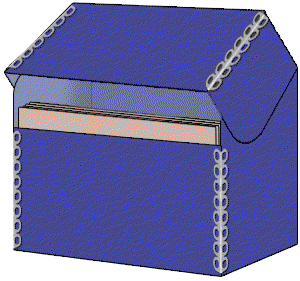
print boxes, designed for flat storage with a shoe-box lid and drop front;
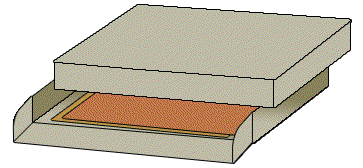
and archival cartons, which are large boxes designed for the bulk storage of archives.
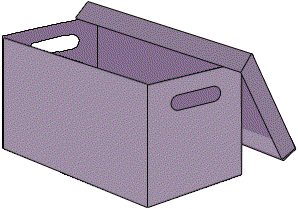
There are also boxes for rolled and other unusually shaped objects. All boxes should be made from board that has a pH of at least 8.5 and a calcium carbonate buffer of at least 3 percent. Document cases are designed for both flat and upright storage. In partially filled upright storage containers, contents should not be allowed to slump. A piece of folded mat board can be used to prevent this.
Map cabinets or steel flat files
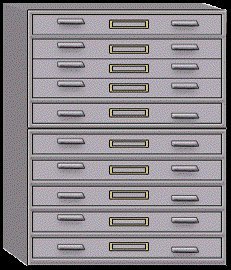 Large materials such as maps and posters should be stored flat whenever possible. Map cabinets should be made from welded steel of at least 14 gauge. The finish should be baked on and preferably made from acrylic resin and melamine.
Large materials such as maps and posters should be stored flat whenever possible. Map cabinets should be made from welded steel of at least 14 gauge. The finish should be baked on and preferably made from acrylic resin and melamine.
Wooden map cabinets should be replaced as soon as possible, because wood releases damaging materials and attracts insects. Typically steel flat files are stacked 2 units high, with each unit consisting of 5 drawers. This produces a height of just under a meter, and provides good work surfaces for staff and researchers.
The objects stored in flat files should be placed in folders that are slightly smaller than the inside measurements of the drawers or exactly half this size. This prevents the movement of folders inside as drawers are opened. Folders contents should generally be limited to no more than 2 to 3 centimeters in thickness, measured at the center of the folders. Steel flat files form a large enclosure and can be used as micro-environments with insect repellent (mothballs) or dessicants in the base. The micro-environment can be detrimental when, for example, the steel flat file stands on a carpet that becomes wet. The damp travels under the flat file, and although the carpet dries in the open areas, the dampness under the flat file causes extreme humidity in the case and results in mold growth.
Rolled objects
These can be difficult to store and access without damage. Most rolled objects can be rolled on the outside of a strong cardboard tube with a diameter of approximately 10 centimeters. The tube should be longer than the object and covered in an alkaline paper, and the object preferably interleaved with an alkaline paper as it is rolled to reduce surface abrasion. The outside of the object is then wrapped in a strong alkaline paper. Under no circumstances should an object be pushed inside a tube as substantial damage can be caused when the object is removed for use.
A refinement of the tube roll is a method developed by the British Public Records Office and refined by an American book conservator, William Minter. This combines the tube with polyester film in a housing that protects the vulnerable object when it is unrolled for use. In this case, the object is rolled around the outside of the tube with two sheets of polyester film formed as a single-weld envelope with one edge of the film attached to the tube. The two sheets of polyester film are welded or attached with double-sided tape close to the leading edge with the two sheets extending without welds beyond the document at the top and bottom. The trailing end of the envelope has a protector of cloth that is tied with the oversized width tucked inside the ends of tube.
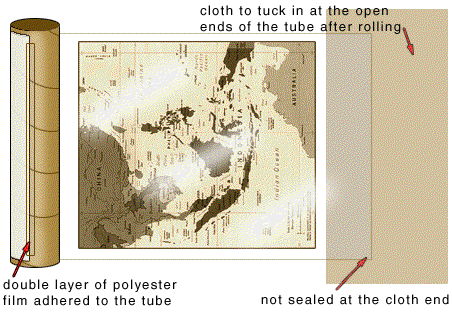
To use the object, the roll assembly is unrolled but the object not removed but viewed in the enclosure. This protects the object from re-rolling, which often results in serious damage.
Housing photographs
Ideally, because of their wide variety, photographs should be housed separately. Enclosures should be made from acid-free paper or stable plastic. Paper is opaque, which prevents light damage but requires photographs to be pulled from their envelope or sleeve to be viewed. Plastic is transparent and reduces the handling necessary to view the photographs. However, plastic is a disadvantage in conditions of high humidity, as it can lead to ferrotyping (shiny patches on the surface) or mold. Plastic should not be used when the emulsion surface is damaged, because the electrostatic property of plastic can lift off surface flakes.
Paper enclosures
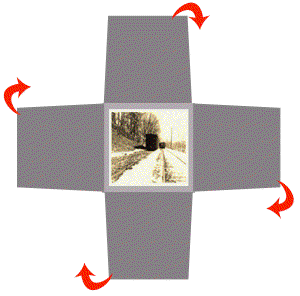 Paper enclosures should have a high alpha-cellulose content and be free of ground wood,alum-rosin sizing, and sulfur. They should also have a pH of up to 7.5 and a smooth surface. Enclosures with construction seams or overlaps pose the risk of adhesive deterioration on the print surface. A four-flap enclosure that does not involve abrasion is preferred for many photographs.
Paper enclosures should have a high alpha-cellulose content and be free of ground wood,alum-rosin sizing, and sulfur. They should also have a pH of up to 7.5 and a smooth surface. Enclosures with construction seams or overlaps pose the risk of adhesive deterioration on the print surface. A four-flap enclosure that does not involve abrasion is preferred for many photographs.
When placed in individual enclosures, photographs may be stored in boxes similar to those used for paper. The photographs may be stored horizontally or upright but must be under slight pressure to avoid curling. If photographs of drastically different sizes are to be housed in the same box, a divider mat board can be placed in between. Oversize photographs can be stored in folders inside large print boxes or in steel flat files. Framed photographs are best removed from their frames for storage. If the photograph is extremely large, it should be unframed and acidic support materials discarded and replaced with acid-free materials. A trained conservator should do the reframing.
Prior to storage
Photographs adhered to brittle mount boards should be supported in their enclosures with acid-free mats or corrugated boards cut slightly larger. Under no circumstances should anyone except a photograph conservator attempt to remove the photograph from its mount.
Glass plate negatives should not be stacked flat, one on top of the other, as the weight can cause serious damage, especially if some of the plates are slightly curved. They should each be placed in a paper enclosure and stacked on the long edge in their box, with a piece of acid-free board placed every five to ten plates to maintain stability.
Housing motion picture film
Motion picture film should be secured by winding evenly on stable cores and stored in canisters made from plastic (polyethylene or polypropylene) or metal (non-corrosive and non-ferrous). Acid-free paper or polyester film bands should be wrapped around the film to keep it from unwinding. “Safety” and color film should be enclosed in polyethylene before being placed in canisters. Film made from cellulose nitrate should not be wrapped in plastic; rather, it should be placed directly into a metal canister with the lid slightly loosened and isolated from other film. Film in unstable condition should be duplicated and discarded.
Housing books
Protective enclosures may be necessary for fragile books that must be preserved in their original condition, for loose materials that need to be kept together and for <a href="/glossary#Vellum" title=“Originally, a translucent or opaque material produced from calfskin that had been soaked, limed and unhaired, and then dried at normal temperature under tension, usually on a wooden device called a stretching frame. Now, “vellum” is often used interchangeably with “parchment”.
" class=“lexicon-term”>vellum-covered books.
There are three main box types for books: clam-shell boxes, slipcases, and portfolios
Clam-shell boxes
The clam-shell box may be a fold-back design with two trays hinged in the middle, or a drop-front type. The fold-back is usually best for enclosing books, the drop-front best for enclosing loose materials such as groups of pamphlets. The strongest clam-shell box is one constructed from a sturdy, acid-free board supported with binders’ board and covered in buckram. A very simple form of clam-shell can be made from a single piece of acid-free corrugated board. In the case of palm leaf, individual manuscripts can be placed in MM cases, and four to six of these cases can then be placed into large clam-shell boxes.
Slipcases
Slipcases are open ended and designed to stand on the shelf, with the spine of the book showing. This type of case is useful for loose-leaf volumes or photograph albums to guard against dust infiltration. However, slipcases can be quite damaging to bindings because of the degree of abrasion caused whenever the book is withdrawn from the case. In conditions where the climate is subject to drastic change, books can shrink and expand, making them difficult to remove from slipcases.
Portfolios
A portfolio is used to house large flat books and small thin books. When used for large flat books such as atlases, the portfolio consists of a sturdy binding-type case of board and book cloth with stiff flaps that fold in to secure the contents. Large cases of this type usually have cotton ties at the top, bottom, and fore edge. When used for small thin books, the portfolio consists of a simple case made from thin boards and book cloth with wrap-around flaps made from acid-free folder stock. This case is generally not secured with ties.
Housing sound recordings
There are many types of audio recordings, and although the same basic principles that apply to the housing of other library and archival materials apply here (with acid-free and buffered board paper, and polyester and polypropylene, recommended), there are some differences that are worth noting.
Gramaphone/phonograph discs
The preferred method of disc storage is on edge. Each disc should be placed in a record storage sleeve made from acid-free paper with a circle cut to expose the record label or a sleeve made from polyethylene. If new discs are added to a collection, the original plastic shrink wrap should be removed because it has a tendency to stretch and contract with changing temperatures, which can warp discs. Groups of sleeved discs should be placed in record storage boxes, which are similar in materials and construction to those used for paper. The boxes should have a closely fitting lid to keep out dust. It is important that discs not be allowed to slump in their boxes; divider boards should be used to ensure that the space within the boxes are filled.
Dictaphone belts
These are belts from recording dictaphones used from 1947 on for business, medical, and scientific recordings. The belts were usually stored flat in business file folders, but these cause creasing. The belts should be carefully wrapped around a piece of acid-free board to reduce creasing and placed into a storage box.
Wax cylinders
A product of the late nineteenth century, wax cylinders are common in archives. Generally measuring 10 centimeters in length and 5 centimeters in diameter, cylinders can be brittle and require careful storage and handling. Generally, the cylinders are placed in acid-free boxes that have been divided into compartments or placed on small pillars attached to the bottom of the box so that they stand vertically. Several cylinders are placed in each box. When a wax cylinder is removed from its compartment, it is important that the wax surface not be touched; insert the thumb and index finger into the center and lift by applying finger pressure against the inside of the cylinder.
Reel-to-reel audiotapes
The tape medium of choice is polyester, although for many years acetate was used. Acetate suffers from forms of deterioration called sticky shed and vinegar syndrome, and the only way to preserve the sound content is via re-recording. Because tape is magnetic, it must be kept away from magnetic fields and heat sources. For archival storage, tape should be wound onto a non-ferrous metal reel with the end of the “program” on the outside of the reel. Tape should be spooled tightly for storage into a tape care box, with the weight of the tape borne by the center hub.
Sticky shed syndrome is caused by tape oxidation adhering to the magnetic heads of playback equipment. Oxidation builds up to a dirty residue that seriously distorts sound quality. Vinegar syndrome is the result of celluloseacetate deterioration and can be detected by the distinctive odor and the buckling, shrinking, and brittle quality of the tape. It is important that storage containers for materials suffering from vinegar syndrome not be air tight. The U.S. Image Permanence Institute (www.imagepermanenceinstitute.org) has developed strips that can detect the presence and degree of vinegar syndrome.
Audio cassettes
Cassettes should be stored vertically in their original plastic cases. They should be played through their entire program at least annually to reduce “print through” and sticky shed symptoms.
Housing microform
Microfilm must be exposed, processed, and stored according to international standards. Housing begins with the film being wound onto noncorrosive metal or plastic reels covered with a strip of acid-free paper secured by string ties or Velcro strips. Rubber bands should not be used. The boxes in which the full reel is stored should be made from acid-free board/paper and designed like those recommended for paper. Inert plastic containers are also acceptable storage boxes.
International standards
Most funding agencies require that international standards be followed when research materials are microfilmed with their support. Among other requirements, three generations of film must be produced: the camera or “master” negative, the print negative, and a positive copy. The camera negative must be stored in a low, even temperature and low humidity, ideally in a location remote from the other film generations, and should not be used except under emergency conditions. The filming library or archive should maintain the print negative in good storage conditions and use it for making positive copies on demand. The positive copies are for reader use.
Film deterioration
The inability of many libraries and archives in tropical regions to provide appropriate storage conditions of microfilm negatives is of great concern. Although film produced and stored correctly is known to last for a minimum of 500 years, film in some countries has become unreadable after only twenty years in conditions of high temperature and humidity. In some cases, governments and institutions are reluctant to allow film negatives or copies to leave the country, even though this can spell the end of the film. The solution may be for institutions to cooperate on film storage, perhaps with a commercial company or institution in a temperate country, or through a regional consortium of institutions.